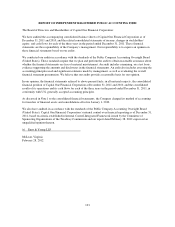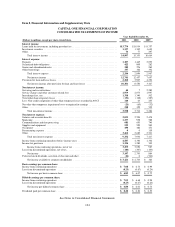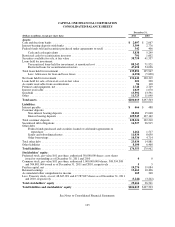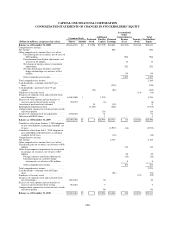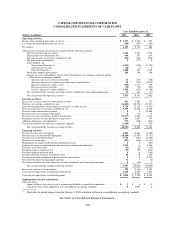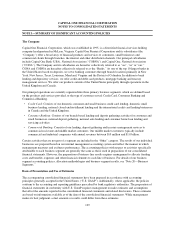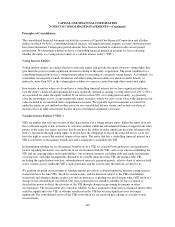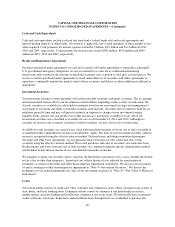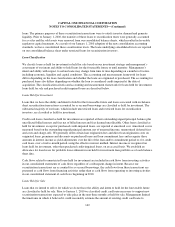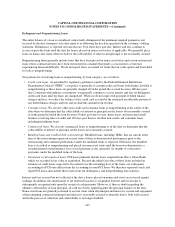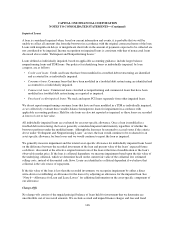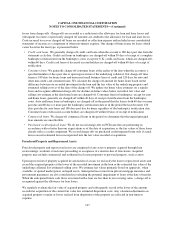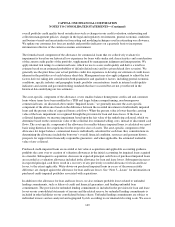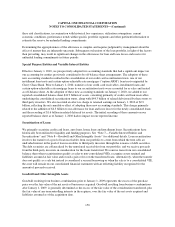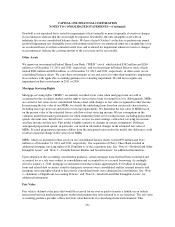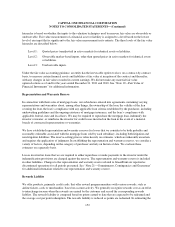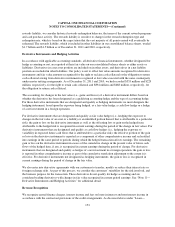Capital One 2011 Annual Report Download - page 163
Download and view the complete annual report
Please find page 163 of the 2011 Capital One annual report below. You can navigate through the pages in the report by either clicking on the pages listed below, or by using the keyword search tool below to find specific information within the annual report.CAPITAL ONE FINANCIAL CORPORATION
NOTES TO CONSOLIDATED STATEMENTS—(Continued)
support securitization transactions to three months because of the uncertainty of customer repayment behavior
and the revolving nature of credit cards.
Loans classified as held for sale are reported at the lower of amortized cost or fair value as determined on an
aggregate homogeneous portfolio basis, with any write-downs or recoveries in fair value up to the amortized cost
recorded in our consolidated statements of income as a component of other non-interest income. We recognize
interest on loans held for sale classified as performing on an accrual basis. Because loans held for sale are
reported at lower of cost or fair value, an allowance for loan losses is not established for loans held for sale. The
fair value of loans held for sale is estimated based on secondary market prices for loan portfolios with similar
characteristics.
In certain circumstances, we may transfer loans to/from held for sale or held for investment based on a change in
strategy. We transfer these loans at the lower of cost or fair value on the date of transfer and establish a new cost
basis upon transfer. Write-downs on loans transferred from held for investment to held for sale are recorded as
charge-offs at the time of transfer.
We execute whole loan sales with either servicing rights released to the buyer or retained. When loans are sold
and the servicing rights are released to the buyer, the gain or loss recognized on the sale is calculated based on
the difference between the proceeds received and the carrying value of the loans sold. When loans are sold and
the servicing rights are retained, the fair value attributed to the retained servicing rights impacts the gain or loss
recognized on the sale. We report gains or losses on loans held for sale when realized in other non-interest
income.
We originated $954 million and $1.2 billion of conforming residential mortgage loans for the years ended
December 31, 2011 and 2010, respectively. We retained servicing on approximately 91% and 82% of the
conforming residential mortgage loans we sold for the years ended December 31, 2011 and 2010, respectively
and recognized gains of $28 million, $1 million, and less than $1 million of the sale of held-for-sale loans for the
years ended December 31, 2011, 2010, and 2009, respectively.
Loans Acquired
All purchased loans, including loans transferred in a business combination, acquired on or after January 1, 2009,
are recorded at fair value at the date of acquisition. Accordingly, any related allowance for loan losses is not
carried over.
Loans acquired with evidence of credit deterioration since origination and for which it is probable at the date of
acquisition that we will not collect all contractually required principal and interest payments are considered
purchased credit impaired (“PCI”) loans. Evidence of credit deterioration may include statistics such as
delinquency and accrual status, current loan-to-value ratio, the geographic location of the borrower or collateral
and internal risk ratings. In connection with the acquisition of Chevy Chase Bank on February 27, 2009, we
concluded that the substantial majority of loans we acquired from Chevy Chase Bank were PCI loans. See “Note
2—Acquisitions and Restructuring Activities” and “Note 5—Loans” for additional information.
In accounting for PCI loans we first determine the contractually required payments due, which represent the total
undiscounted amount of all uncollected principal and interest payments, adjusted for the effect of estimated
prepayments. We then estimate the undiscounted cash flows we expect to collect. We incorporate several key
assumptions to estimate cash flows expected to be collected, including default rates, loss severities and the
amount and timing of prepayments. We estimate the fair value by discounting the estimated cash flows we expect
to collect using an observable market rate of interest, when available, adjusted for factors that a market
143


